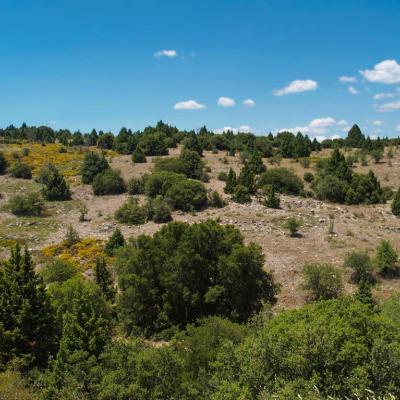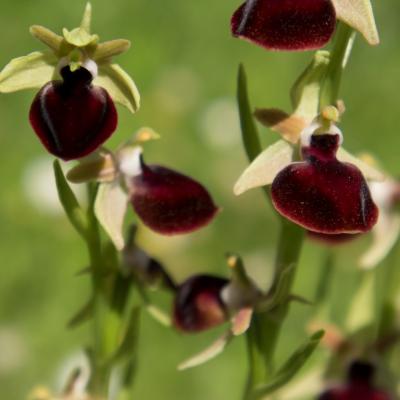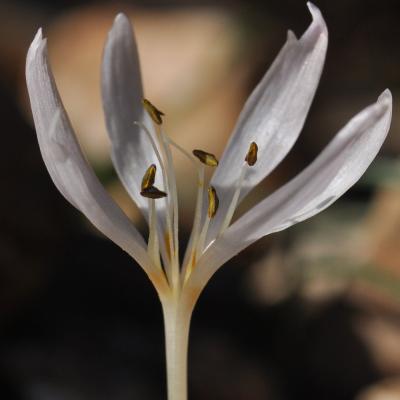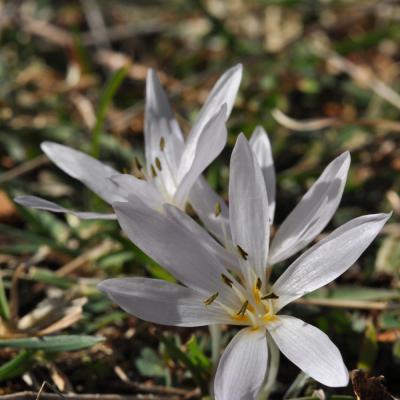Plant of the month
Crocus macedonicus Rukšāns was only recently discovered (in 2012) on the southern slopes of Mt Vertiskos in Macedonia. Initially, it was believed that this species has a very limited distribution, only in a few places, but afterwards it was proved to exist on all the southern slopes of Mt Vertiskos, at an altitude of 300-700 m; it is considered that Crocus macedonicus distribution tend to be larger. The species is recorded on limestone slopes with low herbaceous vegetation and its flowering period is in October and November.
Vitex agnus-castus (vitex or chastetree) is a deciduous shrub or a small tree (1-4 m), having a layer of down on its square shaped branches and carrying opposite, composite and palmate leaves. Vitex is blooming from July to September and its flowers grow in distinct inflorescences, in shades of red, blue and rarely of white colour. The fruit is a small, aromatic globular drupe, which contains 3-4 seeds.
Family Compositae (Asteraceae), synonym Crepis raulinii Boiss. Perennial with a stem usually erect up to 20(-40) cm in height, divaricately branched above. Basal leaves forming a rosette dentate or slightly lobed leaves, hairy or glabrous. Cauline leaves few, usually bract-like. Involucre cylindrical-campanulate. Outer bracts as long as inner. Receptable densely ciliate, with shiny hairs. Corolla up to 17 mm long, yellow to deep-yellow. Achenes 5-6,5 mm long.
Perennial herbaceous plant with a branched caudex and height 10-60 cm. Flowers purple, inflorescence occupying most of the length of the stem. The species occurs in shaded areas, in rocky habitats, only in areas protected by grazing. The distribution of the species includes Greece, Turkey and Libya. In Greece, it occurs only in the island of Chios, in Mt Pelinnaio.
Paeonia mascula subsp. hellenica is a robust perennial plant, with stems reaching a height of 60 cm. Its large, impressive, cup-shaped flowers, that reach diameters up to 13 cm constitute a fine lesson for floral morphology, as one can identify macroscopically, all the individual floral parts, such as the numerous stamens with the yellow anthers and the tomentose carpels with the bright-red, circinnate stigmatic area. The flowering period lasts from April to June.
Juniperus drupacea (Syrian juniper) is a mountainous, small or medium-sized tree (12-20 m), endemic for the eastern Mediterranean area (Israel, Lebanon, Syria and Turkey). Unique natural populations for Europe are found only in Mt Parnonas and Mt Taygetos (SE Peloponnese), in limestone substrates and altitude 300-1,500 m. It forms pure or mixed forests with J. oxycedrus L., Abies cephalonica Loudon or Pinus nigra J.F. Arnold subsp. nigra.
Helen’s Bee Orchid (Ophrys helenae Renz) is the only Ophrys species that has no speculum on its flowers, while it is easily identified by its velvet cherry red lip, that usually has a yellowish boarder. Although the lip color and beauty are leading to the idea that the species name comes from Helen of Sparta of the antiquity, Jany Renz, who first found and described the species from Corfu in 1928, named it after his mother, Helen Renz.
Linum arboreum is a genuine ornament on the rocks, a very attractive shrub with bright yellow flowers and relatively early spring flowering that will definitely attract your attention. It can reach 1 meter in height although it is usually lower and caespitose. Its leaves are glabrous and thick and its few-flowered compact inflorescences appear from March to May and occasionally from January. It is usually found in rock crevices and rocky slopes with macchie and phrygana vegetation, from sea level up to 900 meters although rarely it can be found up to 1900 meters.
Deciduous tree commonly named alder that thrives in moist soils, reaching to a height of 20-30 m. Anthesis occurs from February to March and seed maturation on October. It grows in deep and moist, clay-sandy soils, often almost in the water, in streams or rivers, usually, at altitudes of 0-1500 m. It needs plenty of light, grows quickly at an early age, stabilizes the river banks very effectively and is very resistant to pruning and flooding. It mainly occurs in North and Central Greece but extends to the Northwest Peloponnese, and to some of the larger islands.
Colchicum asteranthum was discovered relatively recently in 1999, and was described three years later. So far, it has been found only on Lerkio of Peloponnesus, where its distribution is limited to slopes with southwest to southeastern exposure. This very limited distribution makes Colchicum asteranthum one of the rarest species of the genus Colchicum in Greece.















